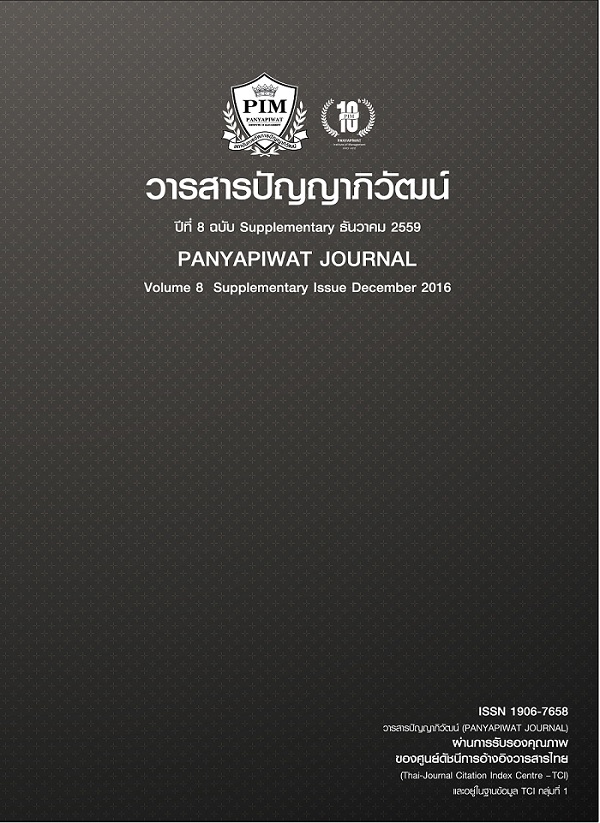HOW IS THE THAI RED CROSS SOCIETY PERCEIVED IN THE SIGHT OF EMPLOYEES
Main Article Content
Abstract
Whatever people perceive can directly and indirectly cause a corporate image problem. The Thai Red Cross Society a national, nonprofit organisation, needs to know how the publics, especially employees perceive the organisation so that an effective communication campaign can be developed. The purpose of this study was, therefore, to study how employees perceived the Thai Red Cross Society systematically. The in-depth interviews were conducted with those who were from public organisations, private companies, state enterprises, and nongovernmental organisations. The findings revealed three sections of perception, i.e. the perception towards the Thai Red Cross Society, the Principles of Red Cross, and the Thai Red Cross Society’s organisations. In general, it was happy to say that the sampled employees had shared, correct perception toward the Thai Red Cross Society. That is to say, the Thai Red Cross Society is a national, nonprofit, neutral, independent, and governmental-support organization where targets to giving assistance to society. In contrast, limited perception and misperception towards the Thai Red Cross Society were, somewhat, discovered as follows. Thus, correct information via appropriate platforms shall be disseminated so that correct experiences can be created and confusion and rumours can also be avoided.
การรับรู้ของบุคคลสามารถก่อปัญหาให้เกิดขึ้นกับภาพลักษณ์ขององค์กรได้ทั้งทางตรงและทางอ้อม สภากาชาดไทยถือเป็นองค์กรสาธารณะกุศลระดับชาติ ซึ่งการรับรู้ของประชาชน โดยเฉพาะอย่างยิ่งพนักงานมีประโยชน์ต่อการพัฒนาโครงการรณรงค์เพื่อการสื่อสารให้มีประสิทธิภาพ ดังนั้น วัตถุประสงค์ของงานวิจัยนี้คือ เพื่อศึกษาการรับรู้ของพนักงานต่อสภากาชาดไทย การวิจัยนี้ใช้การสัมภาษณ์เชิงลึกกับพนักงานของ 4 หน่วยงานใหญ่ ได้แก่ หน่วยงานราชการ หน่วยงานเอกชน หน่วยงานรัฐวิสาหกิจ และหน่วยงานนอกภาครัฐ ผลการวิจัยพบการรับรู้ 3 ส่วน ได้แก่ การรับรู้ต่อสภากาชาดไทย การรับรู้ต่อหลักกาชาด 7 ประการ และการรับรู้ต่อหน่วยงานของสภากาชาดไทย เป็นที่น่ายินดีที่พนักงานจากทั้ง 4 หน่วยงานมีการรับรู้ต่อสภากาชาดไทย การรับรู้ต่อหลักกาชาด 7 ประการ และการรับรู้ต่อหน่วยงานของสภากาชาดไทยได้อย่างถูกต้อง อย่างไรก็ตาม พนักงานยังมีการรับรู้ที่จำกัด และผิดไปบ้าง ดังนั้น จึงจำเป็นอย่างยิ่งที่สภากาชาดไทยจะต้องสื่อสารข้อมูลที่ถูกต้อง โดยเลือกใช้ช่องทางการสื่อสารที่เหมาะสมกับกลุ่มเป้าหมาย เพื่อสร้างประสบการณ์ที่ถูกต้อง และเพื่อหลีกเลี่ยงความสับสน และข่าวลือที่จะเกิดขึ้นเช่นเดียวกัน
Article Details
I and co-author(s) certify that articles of this proposal had not yet been published and is not in the process of publication in journals or other published sources. I and co-author accept the rules of the manuscript consideration. Both agree that the editors have the right to consider and make recommendations to the appropriate source. With this rights offering articles that have been published to Panyapiwat Institute of Management. If there is a claim of copyright infringement on the part of the text or graphics that appear in the article. I and co-author(s) agree on sole responsibility.
References
Bouchet, D. (2014). What is “Corporate Image” and “Corporate Identity” – and why do people talk so much about it?. Denmark: University of Southern Denmark.
Cheoichanya, P., Wiwatnanukul, M. & Anawatsiriwong, T. (1995). Key concepts in Communications (5th ed.). Bangkok: Yellow Publishing (1998).
Cherry, K. (2015). Women are Driving the Growth of Social Media, New Report Says. Retrieved March 3, 2015, from http://stylecaster.com/women-socialmedia/#ixzz3i0NZTwmO
Clow, E. K. & Baack, D. (2007). Integrated Advertising, Promotion, and Marketing Communications (3rd ed.). USA: Pearson Education.
Ferguson, P. D., Wallace, J. D. & Chandler, C. R. (2012). Rehabilitating Your Organization’s Image: Public Relations Professionals’ Perceptions of the Effectiveness and Ethicality of Image Repair Strategies in Crisis Situations. Public Relations Journal, 6(1), 1-19.
Jaichansukkakij, P. (2012). Corporate Image & Brand Management. Retrieved February 21, 2015, from http://drphot.com/thinkabout/archives/406
Jefkins, F. (1993). Public Relations. London: London Publishing.
Kesaprakorn, P. (2008). Public Relation for Image building. Bangkok: Bangkok University Press.
Kesaprakorn, P. (2011). Strategic Public Relations for Corporate Identity, Image, and Reputation Management. Bangkok: Bangkok University Press.
Kotler, P. (2000). Marketing Management. New Jersey: Prenctice-Hall.
Liu, C. & Holland, P. T. (2014). Chinese and American Perceptions on Nonprofit Organizational Effectiveness. Cambridge Journal of China Studies, 9, 1-16.
Patattanaittikul, W. (2002). Perception Theory. Retrieved February 21, 2015, from http://www.nsru.ac.th/e-learning/advertising/
Phetwong, K. (2014, September 10). Interview. Director Corporate Communication. The Thai Red Cross Society.
Pookasawat, A. (2013). Public Relations for Image Building. Bangkok: Chulalongkorn University Press.
Satawedin, P. (2003). Communication Principle. Bangkok: Parbpim Publishing.
The Thai Red Cross Society. (2013a). Organization. Retrieved March 5, 2016, from http://english.redcross.or.th/node/59
The Thai Red Cross Society. (2013b). The 7 fundamental principles. Retrieved March 5, 2016, from http://english.redcross.or.th/node/45
The Thai Red Cross Society. (2015). Vision, mission, and strategy. Retrieved March 5, 2016, from http://www.redcross.or.th/page/19545
Wongmontha, S. (2003). 108 Public Relations. Bangkok: A. N. Publishing.
Wongsumitra, R. (2004). Public Relations Principle. Chonburi: Faculty of Humanities and Social Sciences.


